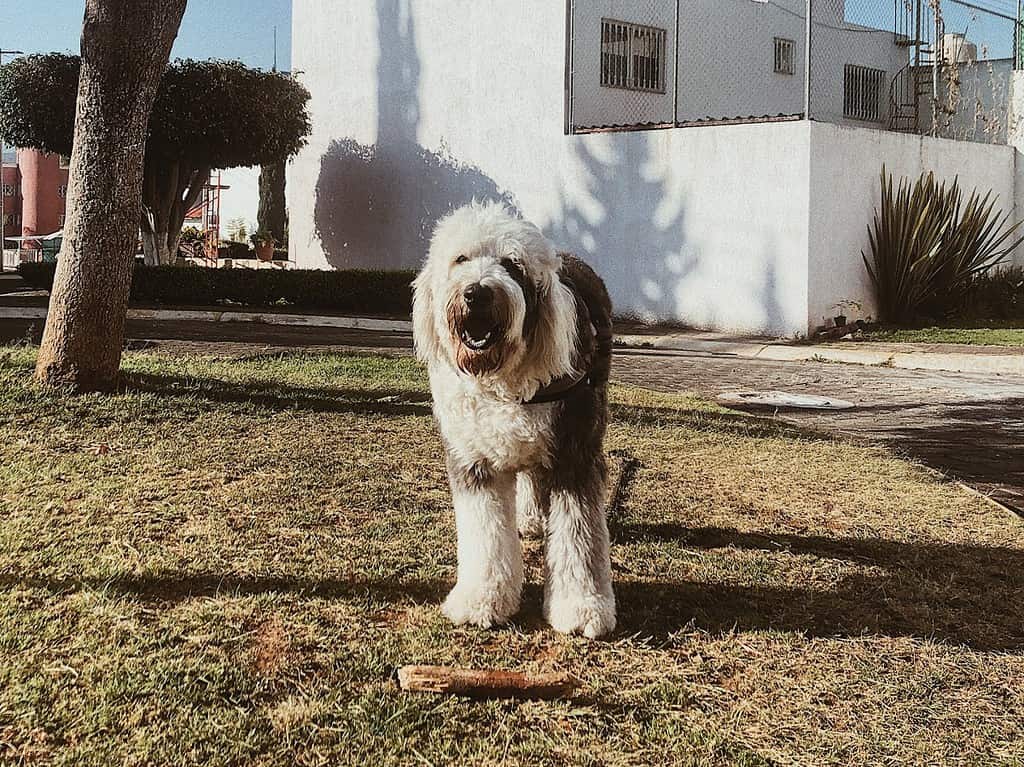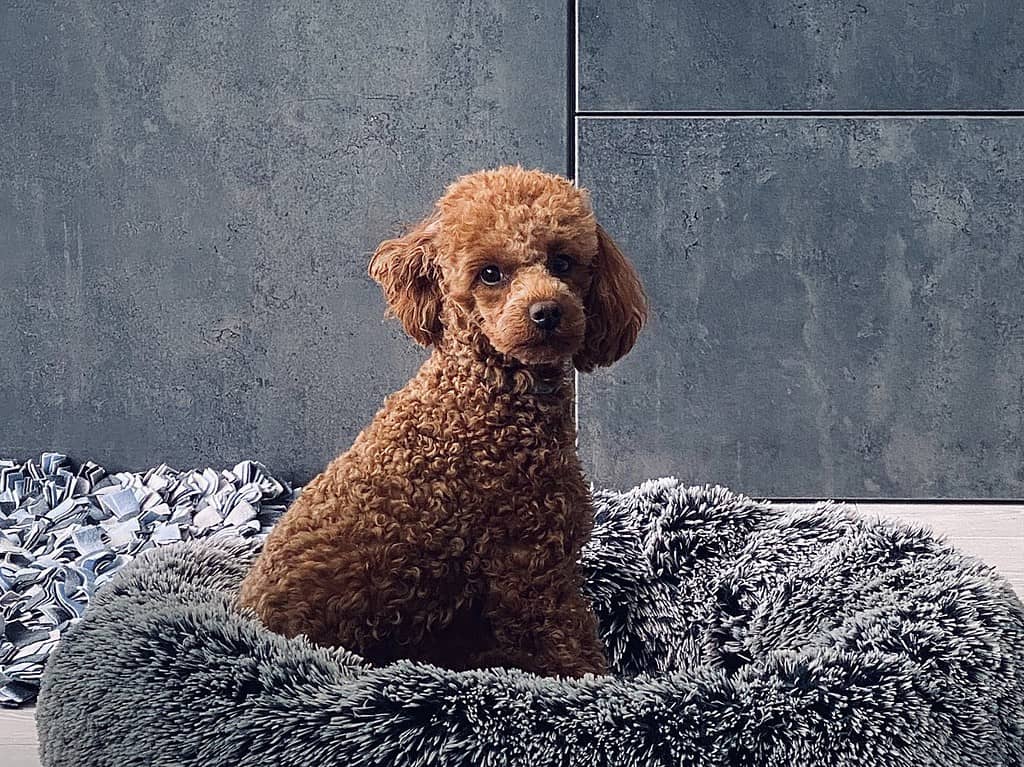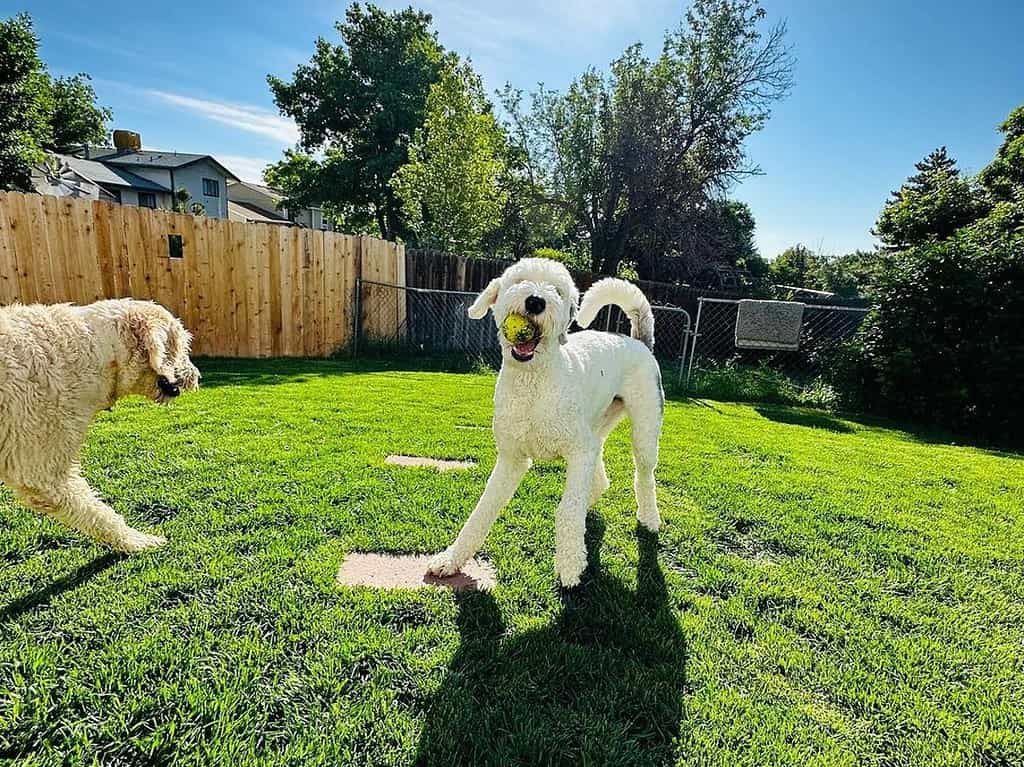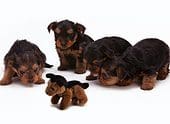Searching for a loyal, playful, and intelligent pet? Consider the Sheepadoodle, created by crossing Old English Sheepdog with Poodle. This combination offers all of the best characteristics attributed to these two breeds, including loving behavior and mental sharpness.
This article provides a comprehensive overview of the important considerations for anyone considering Sheepadoodle ownership. We offer insight into the character traits of these furry companions, proper care techniques, dietary requirements, and grooming needs.

Quick Facts: Sheepadoodle
Height
18 - 27 inchesWeight
65 - 85 poundsLifespan
13 - 15 yearsBreed Size
large (61-100 lbs.)Breed Type
mixedBreed Group
companion, herdingTemperament
friendly, gentle, outgoing, playful, protective, affectionate, active, intelligentGood With
families, other dogs, catsIntelligence
highShedding
frequentExercise Needs
highBarking Level
lowEnergy level
highDrool Amount
lowCoat Type
long, flat/wavy/curlyCoat Patterns
bi-colorColors
black, gray, whiteOther Characteristics
apartment-friendly, cold weather tolerant, easy to groom, easy to train, good for first-time pet owners, prone to health issues, strong loyalty tendenciesSheepadoodle Highlights
- Sheepadoodles can develop a positive relationship with animals in their living environment if proper rules of socialization are observed. Introductions should be made gradually and calmly from an early age to ensure the highest probability of success. Furthermore, it is essential to know that these animals are renowned for being intelligent and social creatures, thus making them more prone to seek companionship provided by other pets in the household.
- Sheepadoodles are known for their pleasant dispositions with children and can provide companionship to adults and young individuals alike.
- Due to the incredible emotional attachment that Sheepadoodles can form with their owners, they have become widely favored as therapy and emotional support animals. Yet, these dogs bear an immense need for closeness with their owner and cannot be left without supervision for extended periods. This makes it difficult for owners frequently away from home to properly care for them without a professional doggy daycare or dog walker.
- Sheepadoodles require daily exercise through walks and fetch, while mentally stimulating activity must be provided to prevent destructive behaviors due to boredom.
- Sheepadoodles may benefit people with allergies because they tend not to shed frequently. Still, regular brushing is necessary.
- The primary shade of Sheepadoodles is a combination of black and white, yet it can potentially be entirely black in some instances or even gray.
History
In the late 20th century, crossbreeding of Old English Sheepdogs and Poodles was initiated in North America with ventures to incorporate the desirable features of both parent breeds. Primarily, this hybridization sought to join together the intelligence and low-shedding nature of the Poodle along with the pleasant disposition and captivating presence of the Old English Sheepdog.
During the early 2000s, the demand for hypoallergenic and low-shedding breeds of dogs that also possess desirable traits such as being gentle around children, highly trainable, and sociable saw a marked increase. The Sheepadoodle emerged as an ideal family pet in response to these criteria, swiftly establishing itself as a reputable contender.
The Sheepadoodle’s fame has grown considerably, with many of its proprietors appreciating their intelligence, dedication, and loving disposition. They are frequently held in high regard as a hypoallergenic breed due to their Poodle roots providing them with an allergy-resistant coat.
The Sheepadoodle, while not recognized as a standardized breed by renowned kennel clubs, such as the American Kennel Club and United Kennel Club, has gathered worldwide fame among pet lovers. Breeders are devotedly striving to define this breed’s standards further and promote consistency in traits.
To accurately understand the Sheepadoodle’s origins, we must explore its parent breeds’ backgrounds.
Old English Sheepdog

The Old English Sheepdog has a long legacy associated with providing services on farms. From herding and managing livestock to eventually becoming one of the more popular breeds for companionship and show, its unique looks, intelligence, and agreeable temperament have made it especially appreciated by dog lovers everywhere.
Old English Sheepdog was primarily bred with a specific purpose: to fulfill the demanding responsibilities of herding and driving sheep and cattle. Boasting a thick, repellent coat suitable for the temperamental British climate, its sturdy build and liveliness make it an exceptional asset for circling livestock. Its cleverness, strong intuitions, and capacity to perform tasks independently earned it high respect among sheepherders of that time.
In the late 19th century, the Old English Sheepdog was formally acknowledged as a breed. This recognition started in 1873 as “Shepherd’s Dog” after debuting at a dog show in Birmingham, England. Its distinct features and formidable working capabilities quickly made them famous and sought after among dog owners.
In 1885, the founding of the Old English Sheepdog Club in England facilitated efforts to promote and preserve this breed. The initial constitution for the club included a definitive description of physical features and personality traits, which later became known as its established “breed standard.” This set of criteria distinguished it from other dog breeds and guided those who sought to breed these animals.
By the start of the 20th century, the Old English Sheepdog had earned itself a name as an excellent working animal and a beloved companion and show dog. Their gracious and mild temperament and significant presence made it a preferred choice among dog admirers.
The American Kennel Club began officially registering Old English Sheepdogs in 1888, and by 1914 the breed had made its debut at a prestigious institution such as the Westminster Kennel Club.
The Old English Sheepdog experienced a considerable surge in recognition during the 20th century, with increased demand across Europe and North America. Due to its unique physical characteristics and typically friendly character, it became a favorite pet among families. It achieved celebrity status within popular culture, where it was represented as an affectionate and dependable companion.
Over the past few decades, the use of Old English Sheepdogs as working dogs has decreased drastically. Instead, they have become popular family pets and exhibition dogs. Nonetheless, conscientious breeders are preserving its herding capacities, ensuring it maintains its instinctual and cognitive capabilities.
Presently, the Old English Sheepdog is generally kept as a companion and show dog. However, it has maintained its instinct to herd animals. It requires systematic grooming to maintain its distinct coat. Despite its unkept façade, this breed is widely acknowledged for its cheerful, warmhearted, and sociable character. Due to their large physique and personable character they are commonly called gentle giants.
Poodle

The Poodle’s history is lengthy and captivating. It is believed to have originated in Europe in the 15th Century, most notably in Germany and France. Though its early development is uncertain, the ancestor of the Poodle was a water dog.
It is claimed that the word “Poodle” was derived from the German term “Pudel,” which translates as ‘to splash in the water.’ This suggests that this canine breed was initially developed as a retriever of water-based objects or animals. The Poodle’s curly and dense coat allowed it to thrive even in marine environments due to its insulation capabilities and buoyant nature.
Initially, the signature grooming of Poodles, featuring shaved areas on their bodies and pom-poms at calloused parts like joints and tails, was conceived with a useful purpose. The shaved areas increased the animal’s ability to swim, while the pompoms provided insulation from cooler temperatures. Over time, those practical techniques have become embellished for aesthetic purposes, leading to the sophisticated styles associated with today’s Poodles.
During the 16th and 17th centuries, Poodles garnered attention from multiple European royalty. Their intelligence, willingness to be trained, and impressive physical attributes allowed them to become members of high society in various European courts. Notably, when Louis XVI held reign over France, he declared Poodles the official dog of his court due to their dignified mannerisms and the ability for water retrieval. As a result, this breed became highly esteemed among aristocrats.
During the 18th and 19th centuries, Poodles were utilized as performing dogs in circuses and traveling shows due to their skillful intelligence, physical agility, and ability to learn behaviors rapidly. They frequently demonstrated tricks, dances, and comedic acts, which developed their popularity as intelligent, adaptable pups.
Poodles have become well-known as show dogs and pets, yet they still employ their original purpose of retrieving games from the water. Hunters value their effectiveness in aquatic hunting, specifically for obtaining waterfowl; their webbed feet and waterproof fur allow them to work effectively in marshes.
During the 19th century, Poodle enthusiasts looked to ensure uniformity regarding their physical features and behavior. To do this, breed standards were implemented to guide breeding programs. These standards established the size divisions among Poodles, including Standard, Miniature, and Toy varieties.
Over the twentieth century, the Poodle achieved ever-increasing success and renown worldwide. Many admired their poise and beauty as they competed in dog shows, while others praised their proficiency in elaborate hairstyles. These dogs also filled important roles as service animals, providing invaluable aid to those who are visually impaired, hearing impaired, or required therapy services.
Poodles are held in high regard across the globe for their intelligence, versatility, and hypoallergenic coat. This has led to them being among the most celebrated dog breeds, often desired as exhibitors, family companions, or working dogs. They have gained immense popularity thanks to their ability to adjust to different conditions and activities.
Appearance


A notable size and roundness, with a pronounced stop, characterize the Sheepadoodle’s head. Its eyes are typically medium to large and vary from brown to blue. Furthermore, the ears are similar to a Sheepdog, tending to be floppy and hang down.
Sheepadoodles possess a muscular and proportional physique, showcasing their working dogs heritage. A substantial chest, powerful legs, and a straight back characterize the body of this breed. While it resembles the appearance of the Sheepdog from afar, up close, one sees more sophisticated qualities in line with that of a Poodle.
The Sheepadoodle has a tail that is typically long and reaches the hock or further. It hangs down and is maintained in an angled position.
Overall, the Sheepadoodle is charismatic, with its fluffy, curly coat and teddy bear-like features. Its alert and intelligent expression display its understanding and attentiveness to the environment around it.
It is crucial to remember that Sheepadoodles can differ in their physical characteristics, even amongst the same litter, due to the variance of genetic traits stemming from both parent breeds. Generally speaking, some may appear more like a Poodle, and others look more similar to a Sheepdog. Moreover, how they are groomed, or cut can also affect the overall look of a Sheepadoodle.
Sheepadoodle Size
Sheepadoodles are large dogs, typically weighing between 65 to 85 pounds). They stand at a height of around 18 to 27 26 inches at the shoulder.
Sheepadoodle Colors
Sheepadoodles commonly feature a black color caused by inheritance from the Old English Sheepdog and the Poodle. This may manifest as a solid black coat with white markings or patches.
The breed can also have a predominantly white coat and a gray coat, which may be light silver or dark charcoal. This coloration is inherited from the Old English Sheepdog parent breed.
Coat
Sheepadoodles often have coats of varying textures, ranging from flat to wavy to curly. These pups are ideal for individuals with allergies as their shedding tendencies and need regular grooming every eight weeks. A daily brush is recommended to avoid any matting in the coat.
Owing to the length of their coats, Sheepadoodles can generally tolerate lower temperatures more effectively. In hot climates, it is recommended that their fur be kept trimmed short to reduce the likelihood of heat-related issues occurring due to the long coat.
Personality
Because Sheepadoodles are mixed, so a dog’s personality can vary greatly. However, some general characteristics are often associated with this breed.
Intelligent
Sheepadoodles are known for their exceptional intelligence, which results in swift learning. This facilitates the training process, making it efficient and enjoyable for all parties involved. Not only can these dogs rapidly assess the notion of positive reinforcement training, they also respond optimally to rewards and compliments.
This dog breed has an instinctive desire to please its owners, leading to faster learning and receptiveness to commands. With its intelligence, it can comprehend and memorize orders with relative ease. This species is also renowned for its excellence in obedience training, agility training, and various dog sports.
Sheepadoodles demonstrate remarkable abilities in problem-solving. Through analysis and evaluation, they are largely able to come up with new and innovative methods for tackling problems or hardships. Their acute intelligence grants them the capacity to survey their surroundings and make informed decisions that lead to successful outcomes. This virtue lends them an impressive adaptability when it comes to handling different scenarios.
The Sheepadoodle boasts remarkable cognitive ability, which enables them to adjust rapidly to changes in habitat and routine. Whether placed in an urban or a rural home, these animals are capable of thriving given the availability of stimulation and activity.
More importantly, these dogs have high social intelligence, permitting them to accurately read the emotions and body language of their human companions. They are highly adept at recognizing their owner’s desires and offering comfort when necessary. This renders them ideal therapy dogs or perfect pets for people with unique requirements.
Affectionate
Sheepadoodles are renowned for their emotional attachment to their owners. This endearing attribute permits them to create strong ties with humans, rendering them dependable partners and unwavering confidantes. Offering immense satisfaction from regular socialization with their owners, the bond formed provides both owner and dog security and solace.

These dogs possess an acute comprehension of their owner’s mental states and can serve as a source of consolation during struggle. Their endearing nature further facilitates them to be highly proficient in providing emotional assistance, thereby creating a peaceful vibe for those they care for with unwavering devotion.
Sheepadoodles have been known to positively influence the psychological health of their owners. Prolonged petting and interaction with these loving dogs are associated with decreased levels of stress, alleviation of anxious thoughts, and release of oxytocin hormones that induce peace and increase good spirits.
Additionally, their caring nature makes them apt to offer consolation and psychological aid in medical facilities, nursing homes, and other treatment locations. They can even be educated to assist individuals going through physical hardships or mental tribulations, reminding of the essentiality of these creatures as therapy animals.
Friendly and Social
Their social demeanor allows them to adjust to distinct family units. Featuring a tolerant and kind nature, they can be compatible with homes that include children. In addition, these dogs are often excited participants in activities and serve as positive companions for the whole family.
Sheepadoodles typically display friendly demeanor towards other animals, such as dogs and cats. This predisposition towards positive interspecies relations often contributes to the development of amiable connections between them and other pets, thus allowing for cooperative relationships in multi-pet households. Additionally, their sociable nature permits Sheepadoodles to participate in leisure activities with others of their kind; ultimately providing an enriching environment for socialization.
Sheepadoodles typically demonstrate a sociable disposition and are often hospitable towards individuals outside their immediate family. This makes them well-suited for therapeutic visitations and public assemblies.
Playful and Energetic
The Sheepadoodle is a breed known for its active character, which creates an opportunity to form strong relationships with their owners. Engaging in playtime allows for interaction and connection, further establishing the emotional tie between the dog and human, encouraging a feeling of togetherness and loyalty.

Furthermore, activities that challenge their minds, such as puzzle toys, interactive games and training exercises can be utilized to embrace their natural playful nature. Taking part in these tasks helps maintain alertness and avoids feelings of agitation or distress. Allowing them time to engage in behaviours including chasing, bringing back or pulling encourages stimulation both mentally and physically which functions as an advantageous avenue for them to relax.
And because of their high energy levels, these dogs require consistent physical exercise. Engaging them in activities like fetch, running, or agility training will reduce excess energy, support a healthy weight, and promote general physical fitness. Regular exercise is necessary for their comprehensive wellness as it boosts cardiovascular health, intensifies muscle and joint strength, and decreases the odds of obesity.
Lastly, their energetic and lively personality makes them wonderful partners for families, especially those with active lifestyles or children. Known to be tolerant and gentle of young family members, these pets are suitable for households with kids. Their amiable attitude ensures that they actively engage in family activities, thus establishing lasting memories.
Protective
Owing to their strong attachment to owners, Sheepadoodles are well-regarded for their capacity to provide unfaltering loyalty and devotion. Their natural inclination towards protective behavior can be incredibly advantageous in potentially dangerous scenarios; thereby ensuring the security of family members and the preservation of their safety or welfare.
As mentioned, Sheepadoodles are often characterized by their gentle and patient temperament which makes them a suitable companion in family households. In addition to this trait, these animals possess a vibe of protectiveness towards young family members. By doing so, they assume the role of an innate guardian who provides both surveillance over children as well as a sense of safety within the home environment.
Health
Sheepadoodles, as with any dog breed, can potentially inherit certain health issues from their parent breeds. It is crucial to understand that not all Sheepadoodles will develop these conditions; however, responsible breeding habits may reduce the odds of inherited diseases.
Hip Dysplasia
Sheepadoodles are frequently affected by a medical issue called hip dysplasia, a condition which involves the deterioration or malformation of the hip joint. This can cause sensations of pain and restricted movement for afflicted dogs. The potential inheritance of this disorder from parent breeds is thought to contribute significantly to its prevalence in Sheepadoodles.
While the precise cause of hip dysplasia remains unknown, evidence suggests that genetics and environmental influences play a role. Studies have identified both Old English Sheepdogs and Standard Poodles as having increased vulnerability to this condition, thereby making any offspring of these breeds more likely to suffer from hip dysplasia as well.
Environmental conditions can play a role in the development of hip dysplasia. If Sheepadoodles experience rapid growth, excessive weight gain, improper exercise levels or inadequate nutrition, their risk for developing this condition increases substantially. To avoid any potential hazards to their health, it is essential to ensure that Sheepadoodles are not overfed and do not engage in high-impact activities at an early age.
Sheepadoodles suffering from hip dysplasia may experience varying levels of difficulty. Common indications include, but are not limited to: limping, problems getting up or jumping, avoiding physical activity, bunny hopping movements and confined range of motion in the affected hips. When left untreated, this condition can result in painful chronic discomfort and deterioration of the joints, which will detrimentally affect their lifestyle.
Depending on the intensity of hip dysplasia in Sheepadoodles, varied treatment plans may be recommended. Moderate circumstances could include tracking bodyweight, restrained exercise, physiotherapy and the utilization of joint supplements to further support joint health. In a case where it is more severe however surgery might be suggested to improve mobility and reduce pain.
Hypothyroidism
A lack of sufficient thyroid hormone production caused by an underactive thyroid gland is referred to as hypothyroidism in canines. This disruption in thyroid hormones is essential to not only metabolism, growth and development but to the dog’s overall health.
With regards to Sheepadoodles, it is important to recognize that they may be genetically predisposed to hypothyroidism as with other breeds. Nevertheless, it should be noted that incidents of this illness can differ between individual dogs from the same breed, implying not all Sheepadoodles are equally susceptible. Even though hypothyroidism cannot solely be attributed to them, their genetic make-up certainly increases the likelihood of occurrence.
Hypothyroidism in Sheepadoodles can be challenging to identify due to its variable signs and symptoms. Amongst the most recurrent manifestations are unwanted weight gain, sluggishness, hair shedding, flaky skin then a heightened sensitivity towards cold, and behavioral changes. These indicators may not always be salient meaning it is important for pet owners to remain observant and contact a vet immediately if there is suspicion of hypothyroidism.
In order to determine whether a Sheepadoodle has hypothyroidism, it is necessary for veterinarians to complete an extensive evaluation including physical examination and blood tests. If the diagnosis is confirmed, its long-term treatment typically requires lifetime medication of synthetic thyroid hormones to restore their concentrations in the body and improve the dog’s quality of life.
Allergies
Sheepadoodles can experience food allergies when their immune system reacts negatively to certain ingredients in their diet. Common allergens associated with such reactions include beef, chicken, dairy products, wheat and soy. Potential symptoms that may arise due to these allergies consist of irritation of the skin, gastrointestinal issues including diarrhea or vomiting episodes.
These dogs have the potential to suffer not only from food allergies but also environmental allergies as a result of substances in their environment, such as pollen, grass, mold spores and dust mites. These can lead to skin problems like itching, redness and recurrent ear infections. Additionally some animals may experience respiratory symptoms like wheezing and coughing.
To accurately diagnose environmental allergies in Sheepadoodles, an extensive medical history must be reviewed, a thorough physical examination conducted, and appropriate allergy testing administered. This can include blood tests or intradermal skin tests which involve injections of common allergens into the skin to analyze any allergic reactions. By determining what specific allergens are triggering the reaction, a more focused treatment plan can then be developed.
Treating allergies in Sheepadoodles may include a variety of management strategies. Dogs with food allergies must have any causative ingredients removed from their diets and be provided with hypoallergenic or limited ingredient foods. To manage environmental allergies, it is important to minimize exposure to allergens by keeping the living area clean, employing air purifiers, and offering hypoallergenic bedding.
Veterinary prescription medication can be utilized to help ease symptoms and provide comfort. Antihistamines, corticosteroids, and medications that moderate immunity are commonly used in order to control itching and swelling. When taking into consideration more severe cases or when allergies do not reply to other remedies, allergen-specific immunotherapy (allergy shots) may be suggested as treatment.
Ear Infections
The longer, droopy ears of Sheepadoodles facilitates an environment which is more conducive to infection. Furthermore, the voluminous and curly fur around their ears creates a haven for dirt, debris and allergens; consequently boosting potential risks of further infections.
Moisture and humidity can play a role in the onset of ear infections. Sheepadoodles, given their affinity for water-related activities, may be at an increased risk of developing bacterial or fungal complications if they enter bodies of water without protection. Moreover, humidity and sweating can cause moisture to accumulate within the ear canal, which could lead to infection as well.
Sheepadoodles may suffer from various signs and symptoms that appear when they have an ear infection. These include vigorously shaking their head, scratching at their ears, having a red or swollen ear canal, emitting bad odors from the impacted area, and copious amounts of wax accumulation within the ear structure. If left untreated then further damage can be done including possible pain, hearing loss, and other significant discomfort.
To minimize the risk of ear infections in Sheepadoodles, regular cleaning is essential. veterinary-recommended ear cleansers should be used to delicately wipe down the ear canals and remove any wax or debris accumulating there. Additional preventative measures such as routine grooming along with complete drying after aquatic activities must also be practiced, further lessening chances of infection.
Epilepsy
Epilepsy is a serious condition often identified by the recurring seizures experienced due to abnormal brain activity. Although the direct cause of epilepsy in Sheepadoodles remains unclear, it is generally accepted that there are multiple contributing elements involved, such as both genetic and environmental influences.
The hereditary nature of epilepsy in SheepaOwners of Sheepadoodles with epilepsy should take proactive steps to ensure the general wellbeing of their pet. This would involve making accommodations such as eliminating potential risks that could cause seizures and developing a regular daily plan which can help reduce stress levels.doodles is a major factor in its development. The genes responsible for the disorder can be acquired from either parent, and may be inherited throughout multiple generations. It is difficult to reliably identify the specific gene associated with epilepsy, which makes it especially hazardous when breeding Sheepadoodles without a complete account of their genetic history as this could potentially increase the risk of passing on such factors.
As well as being a result of genes, seizures in Sheepadoodles can be brought on by environmental stimuli. This could involve contact with certain chemicals or drugs, as well as stress levels, specific infections and blunt force trauma to the head.
Anti-epileptic medications are typically administered to manage and diminish the prevalence of seizures. Experimenting with multiple medications and dosages is often required to establish which option works best for each dog, seeing as their responses can vary. Regular assessment of medication efficacy and alterations may be essential to attain optimal control of seizures.
Owners of Sheepadoodles with epilepsy should also implement lifestyle modifications to support their pet’s well-being. This may include creating a safe environment by removing potential hazards that could trigger seizures and providing a predictable daily routine to minimize stress.
Lifespan
It is not easy to predict the exact lifetime of a Sheepadoodle due to numerous elements such as overall wellness, and level of individual attention. That being said, it is generally estimated that a Sheepadoodle can live an average lifespan between 13 and 15 years.
It is essential to consider that this figure is only an approximate representation, and Sheepadoodles may experience different lifespans depending n their personal situations. Through suitable treatment, nourishment, physical activity, and routine vet exams one can support a long-term and comfortable life for any pup including Sheepadoodles.
Genetic influences are also undeniably important when considering a dog’s life expectancy – particularly for crossbreeds like the Sheepadoodle. Interbreeding offers an improved percentage of beneficial genetic variation, which further decreases the likelihood of particular inherited illnesses that can arise in purebreds.
Care
When it comes to care requirements, the Sheepadoodle has a few specific needs that should be considered. Let’s discuss them inWith regards to its care needs, the Sheepadoodle requires specific considerations that should be taken into account. Let us investigate these requirements in detail.
Exercise: To keep Sheepadoodles healthy and joyful, a moderate amount of physical activity is essential. This can include daily walks, secure playtime in the yard, and interactive games. To additionally challenge their intellects, mentally stimulating activities such as puzzle toys or obedience training are highly recommended.
Health Care: It is essential for Sheepadoodle owners to regularly bring their pet to the veterinarian for proper healthcare, such as vaccinations and check-ups. This not only helps with preventive measures combating any common health issues but also assists in detecting inherited conditions from their parent breeds like hip dysplasia, progressive retinal atrophy, or various skin problems that they may be prone to developing sooner rather than later. Therefore visiting the vet routinely proves beneficial in keeping your pet healthy.
Diet
Depending on an individual Sheepadoodle’s age, size, activity level and overall health status, its dietary needs may change. It would be wise to confer with a veterinarian for tailored advice; however, the following are some general indicators to take into account when fairly assessing the diet of a Sheepadoodle.
Select a commercial dog food of high quality in accordance with the dietary requirements for large breeds. Preferably opt for a brand which contains protein, fat, and carbohydrates with meat as its primary component, excluding artificial additives, fillers, or by-products.
Protein also forms a fundamental part of any diet for a Sheepadoodle, as it contributes to the construction and renewal of bodily tissue, strengthens their immune system and serves as an energy source. Meaty sources high in protein which can be beneficial for Sheepadoodles include poultry (for example chicken, turkey or beef), fish, and eggs. If you choose to provide your dog with a vegan or vegetarian diet then make sure to arrange check-ups with your veterinarian so that all of their nutritional needs are met correctly.
Fruits and vegetables represent valuable sources of vitamins, minerals, and fiber if added to a Sheepadoodle’s diet in appropriate quantities. Acceptable choices include carrots, sweet potatoes, blueberries, apples, cauliflower, brussel sprouts, broccoli, green beans etc.
Note: Portion control is a major consideration when determining the nutritional needs of a Sheepadoodle. Overfeeding or underfeeding can both be detrimental to the animal’s health, as obesity may result in various health complications. Therefore, it is important to monitor your dog’s weight and adjust portions accordingly while keeping in mind guidelines suggested by food manufacturers as a starting point. It must however remain flexible depending on individual needs of your pet.
Grooming
Taking proper care of a Sheepadoodle is no small matter; it requires consideration of numerous factors, such as maintaining their coat, providing baths, brushing, and more. We will now proceed to explore each of these components in greater depth.
Coat Care: Sheepadoodles have a fur coat that requires regular care. It is typically thick and has either wavy or curly hair, which classifies them as low-to-moderate shedding dogs, making them suitable for individuals with allergies. Nevertheless, their coat needs to be tended to diligently in order to prevent matting and ensure it appears neat and well-kept. Brushing the fur once or twice a week with a slicker brush or wide-tooth comb can help eliminate excess fur, dirt particles, and tangles from the coat.
Bathing: Bathing a Sheepadoodle every 4-6 weeks, or as necessary based on their physical activity and coat condition, is essential to upkeep the dog’s health. It is recommended to apply only high-quality shampoos that are gentle enough for their skin and coat in order to clean them thoroughly while avoiding any unexpected side effects. Afterwards, make sure you dry the dog properly by using a towel and following up by using a blow dryer at a low temperature; this will reduce the potential of developing any skin related issues caused by dampness..
Brushing: It is vital to brush a Sheepadoodle on a regular basis in order to preserve the coat’s health and prevent it from becoming matted. Brushing 2-3 times per week is recommended, with specially attention paid to areas that are particularly susceptible to tangles or matting: behind the ears, under the armpits, and around their legs. If an individual finds mats developing within these areas, they should consider employing a detangling spray or dematting tool for removal of those unsightly knots.
Professional Grooming: It is also recommended that professional grooming take place every 6-8 weeks for optimal condition. This will involve trimming the fur on its face, paws and tail in particular to give them an orderly look. Other actions such as cleaning their ears and nails and assessing any skin problems may be addressed as well by the groomer.
Sheepadoodle Puppies
Intelligence and a desire to please make Sheepadoodle puppies highly trainable. To foster balanced development of the dog’s temperament and manners, early socialization and obedience training should be provided. Training can be more successful using positive reinforcement techniques, such as appropriate rewards given for desirable behavior or verbal praise.
Children and Other Pets
Sheepadoodles possess qualities which make them suitable for family life, especially when it comes to interacting with children. They are patient and tolerant of their playfulness, proving to be gentle companions.
However, it’s important to note that early socialization and appropriate training of a Sheepadoodle is essential for it to maintain positive behavior towards children. Teaching dog and children how to interact properly should be undertaken in order to avoid potential accident related injuries. Consequently, parents need to control the interactions between Sheepadoodles and younger kids in order guaranty everyone’s safety.
Additionally, socialization at a young age is essential for Sheepadoodles to form positive associations with other animals such as dogs and cats. It’s important to supervise when introducing them to one another, in order to guarantee the safety of all involved parties and prevent any issues from arising. Still, each canine has their own individual characteristics and hence it is never certain if they will get on or not; some may be more inclined towards making friends while others are less friendly.
Rescue Groups
These organizations specialize in the rescue, rehabilitation, and adoption of Sheepadoodles to make sure they are given proper care and love.
Sheepadoodle FAQS
What breeds are used to create a Sheepadoodle?
The Sheepadoodle mixed breed is reated by crossing an Old English Sheepdog with a Poodle.
Are Sheepadoodles good with children?
Sheepadoodles are known to be lively, attentive, and tolerant, which makes them suitable for households with children. They have been observed to make reliable friends and build attachments with the youngsters they interact with. Moreover, Sheepadoodles usually possess a great deal of energy and take delight in engaging in various activities, such as playing games or strolling around – this is why they can fit into the lifestyle of kids who favor physical activities.
Do Sheepadoodles shed?
Generally, Sheepadoodles show low to moderate rates of shedding hair. While they do shed less than some other breeds, they are not completely without such a trait. In order to preserve the coat’s condition and avoid matting, adhering to a grooming regimen is necessary; specifically, frequent brushing should take place in order to remove loose hairs and reduce shedding overall.
Do Sheepadoodles get along with other pets?
The degree to which Sheepadoodles are able to interact harmoniously with other animals is largely a result of socialization and training acquired while they are still young. If these two factors are attended to in the correct way, a Sheepadoodle can develop a positive relationship with other animals. Consequently, this early intervention plays an important role in how the Sheepadoodle behaves around its peers.
What is the average lifespan of a Sheepadoodle?
Sheepadoodles can live up to 15 years when given proper nutrition, regular exercise, veterinary care, and a loving environment.
Sheepadoodle Fun Facts
- Bunny the sheepadoodle has become a prominent figure on TikTok, garnering attention for her button-speech conversations.
- Through the selective breeding of an Old English Sheepdog and a Poodle, the Sheepadoodle has been produced. This breed e typically showcases curly fur and an overall fluffy appearance.
- Being intelligent dogs, Sheepadoodles do exceptionally well in obedience and agility contests.
References
Panciera, D. (2013). Hypothyroidism in dogs. Clinical Endocrinology of Companion Animals, 263-272.
Anderson, A. (2011). Treatment of hip dysplasia. Journal of Small Animal Practice, 52(4), 182-189.
Ginja, M. M. D., Silvestre, A. M., Gonzalo-Orden, J. M., & Ferreira, A. J. A. (2010). Diagnosis, genetic control and preventive management of canine hip dysplasia: a review. The Veterinary Journal, 184(3), 269-276.




